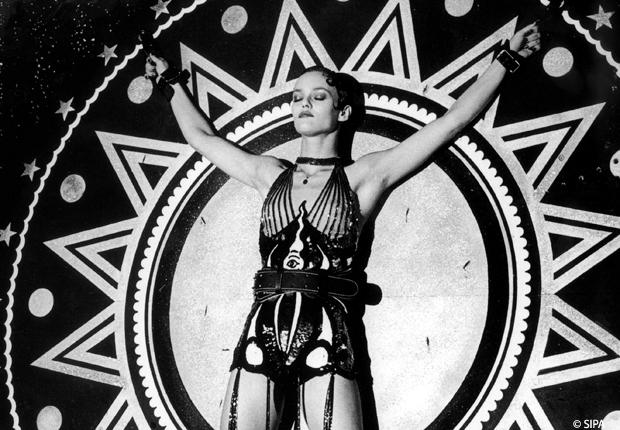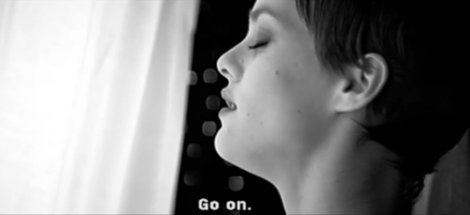Patrice Leconte’s La fille sur le pont (Girl on a Bridge) tells the story of Gabor (Daniel Auteuil), a knife thrower, who returns to a certain bridge in Paris looking for suicidal women to be his assistants, for they, usefully, have nothing left to lose. When he meets Adele (Vanessa Paradis), he finds more than an assistant, he finds a woman who might as well be throwing the knives back.
Though I encourage you to see the whole film, there is one three-minute scene that stands on its own as a well-wrought short film. In this scene, Gabor throws knives at (or, more accurately, near) Adele. The scene derives its power primarily from the intense anxiousness of Gabor and the ecstasy of Adele.
We begin in the audience and then we pinball between the knife thrower, the target, and the faces of those who watch enraptured, fearful, and envious. Much of the pleasure in this scene is derived from the expressions of others in a way similar to Woodkid’s “I Love You.” The chorus of faces in this film that layer and shape how the story is told: the face of a woman in the audience as she leans to see better and, backstage, the various circus performers, the small woman with the massive floral headdress and the stricken clown with the oblivious dog. The circus performers, more than the others, instruct us to be fearful, because they do this for a living every day but they seem worried.
We are all of them and yet we are not simply them. The camera lets us behind the sheet and in a medium shot we get to see what Gabor cannot: Adele’s ecstatic experience. We also see what Adele cannot, in close-up: Gabor’s concern, his worry, his focus. Later in the film, Adele and Gabor are able to communicate with one another over great distances, letter writing to one another without the writing, and this seems possible because of their intense connection. This moment reads us back to the theatre and the knife throwing where we, the audience, were caught between them and the sheet lightening connection to the enraptured onlookers. We see we inhabit the air between them all and were, perhaps, amorousness itself.
Of all the spectators in the montage, it is particularly Irene, the woman backstage dressed somewhat like a showgirl, who stands in counterpoint. Irene gives us every indication that she is vicariously deriving a great deal of pleasure from the spectacle. She is identifying with Adele. Does this envy encourage us to also identify with Adele’s pleasure or does it just make Adele’s pleasure more real? Regardless, what plays across her face is a pleasure both envious and nostalgic, as though she too once knew a pleasure like this.
The worried faces, we find out at the end of the scene, were right to worry: one of the knives has nicked Adele and drawn blood. It is for Gabor an admission that he can’t see the way he used to. It also foreshadows that he cannot see Adele clearly enough and this might not bode well for them.
For Adele, the cut is more complicated. What would be different if every knife had lodged perfectly around her and there had been no cut? This is in some ways the knife thrower’s version of Michael Ondaatje’s “The Cinnamon Peeler.”
what good is it
to be the lime burner’s daughter
left with no trace
as if not spoken to in the act of love
as if wounded without the pleasure of a scar
The ecstatic joy on Adele’s face seems connected to this, wounded, the experience now written on her body. Indeed, if all the love songs tell the truth, then the amorous experience threatens the lover the way the knives do here. There is always the threat of loss of the self but the pleasure of being made specific.
That the film is presented in black and white makes this a nostalgic cinema with a hankering for the way romances used to appear on the silver screen. This coupled with Marianne Faithful’s broken glass and whisky vibrato creates a peculiar tension between the nostalgic and the primal. As Roger Ebert notes in his review of the film, its take on romance stands in resistance to the current take Hollywood has on the genre:
Occupations like knife-throwing were not uncommon in silent comedy, but modern movies have become depressingly mired in ordinary lifestyles. In many new romantic comedies, the occupations of the characters don’t even matter, because they are only labels; there’s a setup scene in an office, and everything else is after hours. Here, knife-throwing explains not only the man’s desperation to meet the woman, but also the kind of woman he meets, and the way they eventually feel about each other.
What Ebert is essentially saying is that Leconte here presents a romance that is specific. This is echoed in Gabor’s act of knife throwing. He cannot throw the knives the same way twice. We see him study the contours and outlines of Adele’s body before he pulls the white sheet over her to begin. She has become specific. Even the gesture of pressing his index finger to her forehead pins her in that specificity. Amorous discourse is this battle between the specific and the generic. When “I love you” is the most cliché thing one can say, the rest must conspire to free the sublime experience from the generic.
— R W Gray


